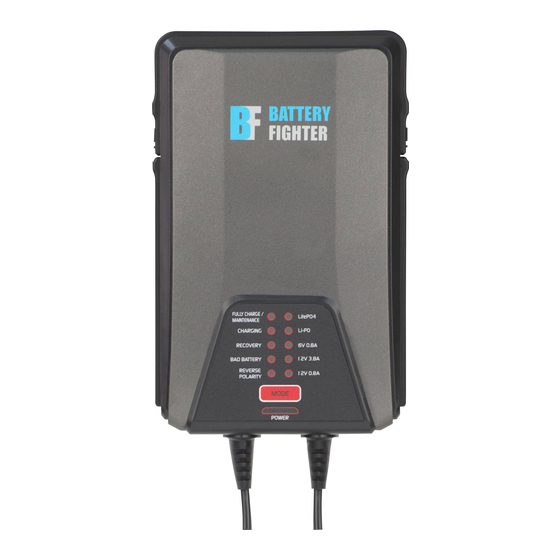Battery Fighter bca1702wr Buku Petunjuk - Halaman 2
Jelajahi secara online atau unduh pdf Buku Petunjuk untuk Pengisi Daya Baterai Mobil Battery Fighter bca1702wr. Battery Fighter bca1702wr 10 halaman. Intelligent battery charger for both lead acid & lithium (lipo & lifepo4) 12v automotive batteries

eye with running cold water for at least 10 minutes and get medical attention immediately.
e.
NEVER smoke or allow a spark or flame in vicinity of battery or engine.
f.
Be extra cautious to reduce risk of dropping a metal tool onto battery. It might spark or short-circuit battery or other
electrical part that may cause an explosion.
g.
Remove personal metal items such as rings, bracelets, necklaces, and watches when working with a lead-acid battery.
A lead-acid battery can produce a short-circuited current high enough to weld a ring or like to metal, causing a severe
burn.
h.
It is not intended to supply power to a low-voltage electrical system or to charge dry-cell batteries. Charging dry-cell
batteries may cause them to burst and cause injury to persons and/or damage to property.
i.
NEVER charge a frozen battery.
PREPARING TO CHARGE
a.
If it is necessary to remove battery from vehicle to charge it, always remove grounded terminal from battery first. Make
sure all accessories in the vehicle are off in order to prevent an arc.
b.
Be sure area around battery is well ventilated while battery is being charged. Explosive gas can be forcefully blown
away by using a piece of cardboard or other nonmetallic material as a fan.
c.
Clean battery terminals. Be careful to keep corrosion from coming in contact with eyes.
d.
If battery is not sealed, add distilled water in each cell until battery acid reaches level specified by battery manufacturer.
This helps purge excessive gas from cells. Do not overfill. For a sealed battery or a battery without cell caps, carefully
follow manufacturers' recharging instructions.
Study all battery manufacturers' specific precautions such as removing or not removing cell caps while charging and
e.
recommended rates of charge.
Determine voltage of battery by referring to vehicle owner's manual and make sure it matches output rating of the
f.
battery charger.
LOCATE CHARGER
a.
Locate the charger as far away from battery as the DC cables permit.
b.
Never place the charger directly above or below the battery being charged. Gases or fluids from the battery will corrode
and damage the charger.
c.
Never allow battery acid to drip on the charger when reading gravity or filling battery.
d.
Do not operate charger in a closed-in area or restrict ventilation in any way.
e.
Do not set a battery on top of charger.
CONNECTION PRECAUTIONS
Connect and disconnect DC output clips only after setting the charger switches to off position and removing AC cord from the
electric outlet. Never allow clips to touch each other.
1.
Follow these steps when battery is installed in a vehicle. A spark near battery may cause a battery explosion. To
reduce risk of a spark near battery:
a.
Position AC and DC cords to reduce risk of damage by hood, door or any moving engine parts.
b.
Stay clear of fan blades, belts, pulleys, and other parts that can cause injury to persons.
c.
Check polarity of battery posts. A positive (pos, +) battery post may have a larger diameter than a negative (neg, -)
post.
d.
Determine which post of battery is grounded (connected) to the chassis. If negative post is grounded to the
chassis (as in most vehicles), see item (e). If positive post is grounded to the chassis, see item (f).
e.
For a negative-grounded vehicle, connect the positive (red) clip from the battery charger to the positive (pos, +)
post of battery first. Connect the negative (black) clip from the battery charger to the vehicle chassis of engine
block remote from the battery and fuel line. Do not connect the clip to carburetor, fuel lines, or sheet-metal body
parts. Connect to a heavy gauge metal part of the frame or engine block;
f.
For a positive-grounded vehicle, connect the negative (black) clip from the battery charger to negative (neg, -)
post of battery first. Connect the positive (red) clip from the battery charger to the vehicle chassis or engine block
remote from the battery and fuel line. Do not connect clip to carburetor, fuel lines, or sheet-metal body parts.
Connect to a heavy gauge metal part of the frame or engine block.
g.
If using permanently mounted eyelet lead SAE connector, simply connect to charger output lead.
h.
Connect charger AC supply cord to an electric outlet.
i.
When disconnecting the charger, disconnect AC cord, remove clip from vehicle chassis, and then remove clip
from battery terminal.
j.
See operating instructions for length of charge information.
2.
Follow these steps when battery is outside the vehicle. A spark near the battery may cause a battery explosion. To
reduce risk of a spark near battery:
a.
Check polarity of battery posts. A positive (pos, +) battery post may have a larger diameter than a negative (neg, -)
post.
b.
Attach at least a 1.8m long 0.75mm³ insulated battery output cable of charger to the negative (neg, -) battery
post.
BCA1702WR - 140717
